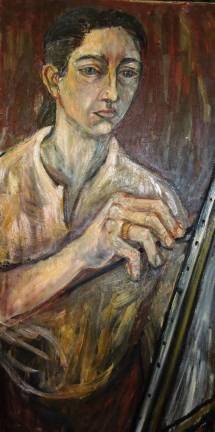Charlotte Lichtblau, Upper West Side artist, ?gr?dies at 88

The German Expressionist remembered by friends and family as 'Lotte'
The painter Charlotte Lichtblau's apartment on the Upper West Side serves as a perpetual exhibition of her life not only as an artist, but also as an exile, émigré, intellectual, and a woman with a profound desire to understand and record her experience.
There's the framed calendar hanging in the bathroom that she made as a child with her grandmother. The text beneath, written in German, says, "If people knew how much we loved each other they would laugh."
In the living room is a portrait of her father, Ernst Adelberg, who in addition to getting his Jewish family out of harm's way in 1938 Vienna, was also instrumental in getting many extended family members to America.
In the dining room is a painting of seemingly disparate objects; a bible and a crucifix, an African mask, a tallow candle and a milkweed pod. "This was her way of seeing the world," said Claudia Payne, Lichtblau's daughter.
The bible depicted in the painting - oversized, leather-bound and hundreds of years old ? was rescued from a bombed-out monastery in Austria and is still in the family. The African mask sits on a nearby hutch.
Charlotte "Lotte" Lichtblau died on Dec. 18. She was 88.
Lichtblau converted to Catholicism in 1961, a minor scandal among her Jewish-Viennese émigré community at the time. According to those who knew her best, she always considered herself both Jewish and Catholic, and considered the latter a fulfillment of Old Testament orthodoxy.
"She was profoundly convinced that she was both Jewish and Catholic," said Father Patrick Ryan, a Jesuit priest and lecturer at Fordham University, who delivered her eulogy.
Under the auspices of a family vacation to Zagreb, Yugoslavia, the Lichtblaus made their way to England and finally to St. Louis in 1940. Eventually, the Lichtblaus moved to New York and settled on the Upper West Side. Lichtblau met her husband, Hans, through a local club for Viennese expats.
Her friend Bruce Payne, who was married to Claudia and is the caretaker of Lichtblau's artistic estate, said Lichtblau was something of an outsider in the New York art scene, as it wasn't exactly in the zeitgeist to earnestly depict religious scenes, let alone take them seriously.
"She was serious about them morally, and she was serious about them in terms of how stories shape our identity," said Payne. "She was always a bit of an outsider to mainstream New York painting, even though a fair number of New York painters, including Philip Pearlstein, thought highly of her work and always came to see it when it was available to see."
Despite the emotionally heavy overtones in much of her work, Payne said Lichtblau was a warm person, often hosting lively dinner parties with Hans. "But she was also, you might say, a kind of heavyweight intellectual, and she was unpredictable a little in how she would react."
Walking around her apartment, at a lifetime of collected work and memory touchstones, it's apparent that art, and its execution, was inextricably linked to Lichtblau's experience of life, war, religion and truth.
When asked once by her daughter why she chose to paint a particular biblical scene, Lichtblau replied simply, "I wanted to see it."